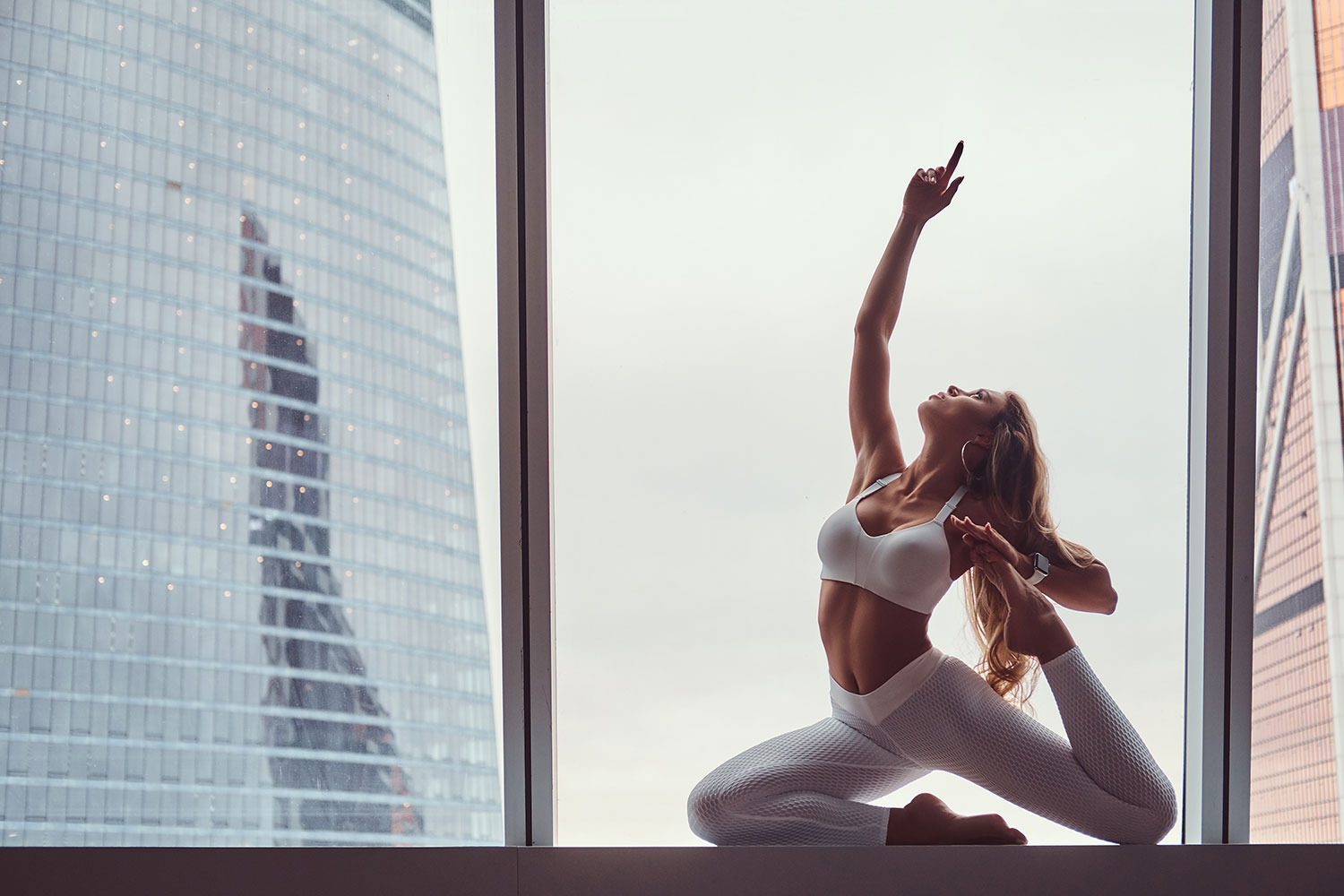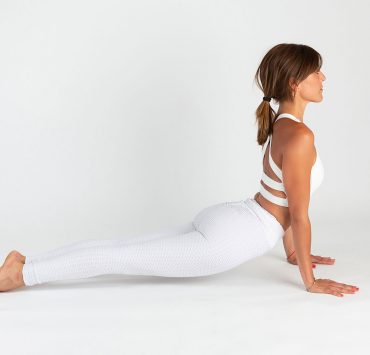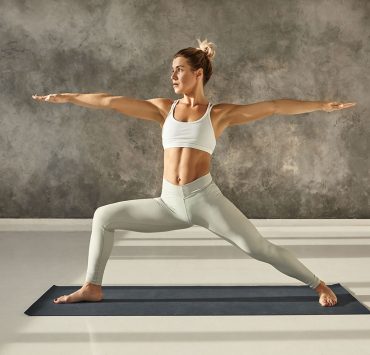
Rose graduated with a degree in Anthropology, which takes her…
There are many benefits of a regular yoga practice, but one of the most often touted benefits is flexibility. Yogis are often viewed as “bendy” or “pretzels,” and it is easy to see where this preconception comes from, when you examine the variety of yoga poses. In fact, many people are scared away from yoga classes or make excuses for not starting a practice, such as they are not flexible enough for yoga. The truth, however, is that yogis are not innately flexible. It is yoga that made them that way! If you are looking to become more flexible, starting yoga or focusing on flexibility in your existing yoga practice could be the answer.
What Does Flexibility Really Mean?

Flexibility is an interesting topic, and so much more complex than it is often given credit for. Most people think of flexibility as solely being due to muscle length or stretch. Its actual definition is more closely related to the body’s pliability, stretchability, and the ability to move joints through their full range of motion. However, there are many other factors that can influence a person’s flexibility and their ability to move joints. These include:
- Skeletal alignment
- Fascia and connective tissue
- Muscle viscoelasticity
- Nerve reflexes
- Genetic predisposition
Therefore, in order to increase flexibility, each of these factors must be addressed. Certain factors such as genetic predisposition may make a person naturally more or less flexible. People have naturally slightly different and unique joint shapes, which can influence flexibility. For instance, a person may be very flexible and open in back bends, but struggle with hip openers due to the natural shape of their pelvis. However, there are still many ways that yoga can help develop flexibility, even in spite of anatomical differences. Lengthening the atagonist muscles and increase muscle fiber viscoelasticity is important in increasing flexibility. Additionally, yoga can also help realign and heal fascia, the collagenous connective tissue that forms over muscles and can limit movement, due to previous injuries or habitual movement patterns. Through the combination of stretching, breathing, and movement that yoga requires, over time this may improve both muscle fiber and fascia extensibility.
Benefits Of Flexibility

Yoga can make us flexible… so what? What exactly are the benefits of flexibility? It turns out there are a huge range of benefits to flexibility, beyond just looking cool and making interesting shapes. First, flexibility is all about increasing your range of motion. This will keep your joints healthy, and also enable you to perform daily tasks with ease, such as reaching into high cupboards, bending to pick things up off the floor, dressing yourself, and more. This is particularly important as we age, and naturally lose this range of motion.
Body is not stiff, mind is stiff. Sri Krishna Pattabhi Jois
Flexibility keeps our joints safe and healthy, reducing chronic pain, fatigue, and even bringing stress relief. When your body is supple and pliable, this will bring ease not only physically but mentally as well.
How Long Should You Hold Yoga Stretches?

Different yoga classes have different paces. This means that in some yoga classes, you will hold yoga stretches for a long time, whereas in others you will speed through them at an aerobic pace. If your goal is to increase flexibility, however, you may be wondering how long should you hold yoga stretches? It is important to pay attention to how long you hold stretching poses. Current research shows that flexibility is only increased with a pose is held for a minimum of 30 seconds. Anything less than 30 seconds shows a statistically insignificant change in flexibility. Additionally, you should be stretching and practicing yoga regularly, ideally every day, in order to increase and maintain flexibility.
10 Yoga Stretches To Increase Flexibility
Some yoga poses will improve flexibility more than others. Similarly, certain yoga poses target certain muscle groups. The following ten yoga stretches will help improve body wide flexibility.
Uttanasana — Standing Forward Bend Pose

Standing forward bend, or uttanasana, is a common yoga pose, performed in the sun salutation sequences and ideal for beginners. It will improve hamstring flexibility.
To perform standing forward bend, stand tall at the front of your mat. Inhale and lift your arms straight overhead. Exhale and fold forward over your legs. Your feet should remain either together or frontal hips width apart. Try to think of rotating your pelvis over your femur bone, rather than rounding the spine. Try and maintain a straight spine. This will ensure the pose targets the backs of the legs for flexibility.
Eka Pada Raja Kapotasana — King Pigeon Pose

King pigeon pose, or eka pada raja kapotasana, is an intense stretching yoga pose. It is commonly practiced in the restorative poses at the end of class, once the body is properly warmed up. It is known as a “hip opener,” meaning it targets flexibility in the hip muscles, including the external rotators, front hip flexors, and psoas.
To practice king pigeon pose, begin in downward facing dog. Inhale your right leg straight back. Exhale and bring the knee forward up to your face. Place the leg down on the mat so the lower leg is parallel to the front of the mat. The tighter from hip muscles are, the more difficult this will be. Although you sould aim for parallel, your leg may be more in the shape of a “7.” Untuck your left toes and lower your left leg onto the mat. From here, you can keep the torso upright. This will target flexibility in your left frontal hip and right hamstring and gluteus. Alternatively, you can walk your hands forward, and drape your torso over your front right leg. This will deepen the stretch in your right hip and psoas. Repeat on each side.
Anjaneyasana — Crescent Lunge Pose

Crescent lunge is a dynamic pose that is often used as a transitional pose during yoga sequences. However, it deserves to be explored in depth, and held for periods of 30 seconds or longer to build flexibility. Crescent lunge targets flexibility in the hip flexors.
When practicing crescent lunge pose, you may approach it a variety of different ways. If starting from downward facing dog, inhale your right leg straight back. Exhale and bend the knee, bringing the right knee to the face. Plant the right foot between the hands, and come onto the ball of the back foot. Inhale and lift the torso straight up, reaching the arms straight toward the ceiling. Maintain alignment with the right knee tracking over the ankle, and in line with the middle toe. Keep the hips level, thinking of bringing the right hip down and back and the left hip forward and up. Whilst strengthening the legs, you will also feel a stretch in your left (back) leg’s frontal hip. Maintain the pose for at least 30 seconds and be sure to repeat on the other side.
Ustrasana — Camel Pose

Camel pose, or ustrasana, is another very intense stretch. It is a back bend that targets flexibility in many of the frontal body muscles, including the quadriceps, hip flexors, abdominals, pectorals, psoas, and more. Because it targets the psoas it may also bring up intense emotions.
Yoga is the fountain of youth. You’re only as young as your spine is flexible. Bob Harper
To practice camel pose, come to your knees. Your knees should be together, feet untucked, with your hips in line with your knees. Throughout the backbend, keep your hips aligned over the knees. Do not let your hips lean back during the pose. Inhale and open the chest. Exhale and slowly walk the hands down the backs of your legs, opening the chest and letting the head drop back as you do so. As the back bend deepens, you may find full posture with both hands clasping the soles of the feet.
Balasana — Child’s Pose

Child’s pose, or balasana, is a calming and grounding posture. It may not be the flashiest of yoga stretches, or even offer the most intense stretch, but it is still known as one of the best yoga stretches for lower backs.
To practice child’s pose, kneel on your mat. The toes should be untucked with the bottom resting on the heels. Inhale and open the heart. Exhale and walk the hands forward on the mat, draping the torso over the legs. As your back is gently rounded over the hips and legs, you will feel a gentle stretching in both the hips and low back.
Parsvottonasana — Pyramid Pose

Pyramid pose, also called parsvottonasana in Sanskrit, is another yoga pose that is often sped through during a yoga sequence and not given its full time for stretching. Nevertheless, it is one of the very best and most intense yoga stretches for the hamstrings.
To practice pyramid pose, begin by standing at the front of your mat. Take your left leg and step it back a couple feet, keeping the hips and feet squared to the front of the room. Find a clasp with your hands either in reverse Namaste, or clasping opposite elbows. Inhale and open the heart. Exhale and, hinging from the hips, extend your torso forward over the front right leg. As you do so, be sure to maintain the alignment in the hips. You will feel a very intense stretch in your front leg’s hamstring. Be sure to hold for a minimum of 30 seconds on each side.
Adho Mukha Svanasana — Downward Facing Dog Pose

Downward facing dog, or adho mukha svanasana, is another essential pose for any yogi. Like standing forward bend, it also targets hamstring flexibilitiy. However, it will help strengthen the back, shoulders, and arms at the same time.
To practice downward facing dog, begin in plank pose with the arms straight and the shoulders aligned over the wrists. Inhale here. Exhale, and press back, lifting the hips toward the back of the room. Keep the feet frontal hips width apart, and the hands shoulder width apart. Maintain engagement in the upper arm muscles and the quadriceps. To particularly target hamstring flexibility, think of the heels grounding into the mat, lengthening through the backs of your legs.
Upavistha Konasana — Wide-Angle Seated Forward Bend Pose

Wide-angle seated forward bend is one of the best yoga stretches for hips. It targets the hamstrings and adductors, or inner thigh muscles, as well.
To practice wide-angle seated forward bend, sit on your mat with your legs straight out front. Bring your legs open to a “V” as wide as you can. Maintain the integrity of your alignment in your low back, by continuing to balance on your sitting bones. Don’t let your pelvis and tailbone roll under you. This will require a great deal of stretching in your adductor muscles. Inhale length through your torso, and exhale and extend your torso straight forward, as far as you can whilst maintaining a straight spine. This will intensify the stretch.
Malasana — Garland Pose

Garland pose, also called malasana in Sanskrit, is a wonderful yoga stretch for the ankles and soles of the feet. It also intensely stretches the groins, inner thigh muscles, and low back.
When practicing garland pose, it may help to think of it by its other name: the yogi squat. Begin by standing tall at the front of your mat. Step your feet apart, wider than your hips. Angle your feet so your toes are pointing away from each other. Bring your hands to Namaste. Inhale here, finding length through your toso. Exhale and bend your knees, squatting down so your sitting bones reach straight for the mat. If possible, try to keep your feels grounded and your feet flat on the mat. Press your elbows against your inner thighs as you maintain Namaste. This will help not only with balance, but will intensify the stretch in the groins and inner thighs.
Baddha Konasana — Butterfly Pose

Butterfly pose, also known as bound angle pose or baddha konasana, is a gentle and restorative posture, often practiced at either the very beginning or very end of practice. It is a hip opener for the inner hips and groin area.
To practice this pose, sit on your mat. Bring the soles of your feet together, and let your knees fall apart. You may either remain sitting upright, or forward fold the torso over the legs.
Conclusion
Remember, ultimately, that yoga is not about who is the most flexible or able to go the deepest in each pose. However, having a flexible body will enable your mind to be flexible. You may find it easier to sit in meditation. After all, the main goal of all asana, or yoga poses, is to enable the body to more comfortably sit in meditation.
What's Your Reaction?
Rose graduated with a degree in Anthropology, which takes her understanding of basic human needs to a whole new level. Her intelligence and passion for healthy living is reflected in her written work.















Very useful information. Thanks for sharing the information with us.